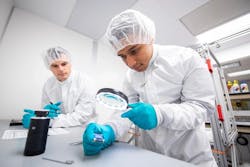DARPA taps RTX Raytheon BBN for quantum optical sensors for SWaP-constrained applications like imaging
ARLINGTON, Va. – U.S. military researchers needed electro-optical enabling technologies to enhance the precision and sensitivity of optical sensors in SWaP-constrained applications like active imaging; atomic sensing; navigation; microscopy; and communications. They found a solution from the RTX Raytheon BBN segment in Cambridge, Mass.
Officials of the U.S. Defense Advanced research Projects Agency (DARPA) in Arlington, Va., announced a $9.3 million contract to Raytheon BBN late last month for the Intensity-Squeezed Photonic Integration for Revolutionary Detectors (INSPIRED) project.
The goal is develop small size, weight, and power consumption (SWaP) optical sensors with sensitivity below the quantum shot noise limit by using so-called squeezed light. Several contractors are expected to participate in this program.
Low-noise detectors are vital components in optical science and technology, DARPA researchers explain. Decreasing the noise in optical detection could increase chances of deploying advanced optical technologies in SWaP-constrained systems.
The quantum sensing advantage of squeezed light to date has not exceeded 10 decibels due to imperfections in even the highest-quality discrete optics. Yet recent advances in nonlinear integrated photonics and heterogeneous integration are beginning to enable chip-scale photonic devices to outperform bulk discrete optical components.
The nonlinear effects that generate squeezed light are more efficient in chip-scale devices than in bulk devices due to stronger field confinement, researchers say. The inherent stability of solid-state photonic circuits and flexible component design also may provide significant performance advantages in manipulating quantum states of light.
The objective of the INSPIRED program is to develop electro-optical detector modules that integrate squeezed-light measurement techniques into form factors comparable to commercial photodetector modules, and increase sensitivity well beyond the quantum shot-noise limit, researchers say.
Getting there, though, will require broad innovation in materials, design, and fabrication to realize chip-scale photonic devices and circuits that efficiently can prepare, manipulate, and detect quantum states of light.
One challenging aspect of the program lies in achieving low aggregate loss in complex multi-component photonic circuits. Other challenges include generating a high squeezing ratio in size- and power-constrained photonic devices. Ultimately, producing such electro-optical systems should enable INSPIRED detectors to measure weak signals with high sensitivity.
The three-year INSPIRED program has two phases to develop a squeezed-light detector prototype. The first phase will develop the central chip-scale photonic devices for a squeezed-light detector, which will include a squeezed-light generator with high squeezing ratio and a phase-sensitive interferometer circuit with low optical loss.
The second phase will demonstrate squeezed-light detector prototypes with sensitivity exceeding the quantum shot noise limit in a module with volume comparable to commercial photodetector components. This will include a prototype module using phase-one test articles.
For more information contact RTX Raytheon BBN online at https://www.rtx.com/who-we-are/we-are-rtx/transformative-technologies/bbn, or DARPA at https://www.darpa.mil.
About the Author
John Keller
Editor-in-Chief
John Keller is the Editor-in-Chief, Military & Aerospace Electronics Magazine--provides extensive coverage and analysis of enabling electronics and optoelectronic technologies in military, space and commercial aviation applications. John has been a member of the Military & Aerospace Electronics staff since 1989 and chief editor since 1995.
